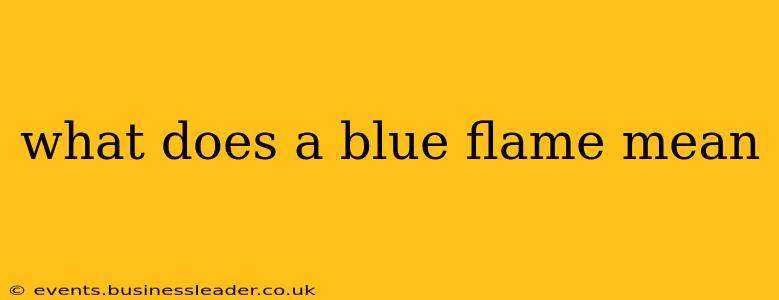A blue flame, often seen in gas stoves and high-efficiency furnaces, signifies a hotter and more efficient burn compared to a yellow or orange flame. But what exactly causes this difference in color, and what does it tell us about the combustion process? Let's delve into the science behind flame color and explore the implications of a blue flame.
What Causes Different Flame Colors?
The color of a flame is determined by the temperature and the composition of the burning material. A flame is essentially a mixture of glowing gases and incandescent particles. The different colors we see are emitted by excited electrons in these atoms and molecules as they return to their ground state.
-
Yellow/Orange Flames: These cooler flames indicate incomplete combustion. Unburnt carbon particles glow orange and yellow, emitting light at lower frequencies. This often means insufficient oxygen is mixing with the fuel, leading to a less efficient burn and the production of soot.
-
Blue Flames: Blue flames represent complete combustion. At the higher temperatures of a blue flame, the energy released excites electrons in the gas molecules to higher energy levels. When these electrons return to their ground state, they emit light in the blue part of the visible spectrum. This means the fuel is burning completely, with maximum energy released and minimal waste products.
Why is a Blue Flame Hotter?
The higher temperature of a blue flame is a direct result of complete combustion. When fuel burns completely, it releases all its potential energy as heat. Incomplete combustion, on the other hand, leaves some energy trapped in unburnt fuel particles, resulting in a lower overall temperature.
Is a Blue Flame Always Better?
While a blue flame generally indicates efficient combustion, it's not always universally "better." The ideal flame color depends on the context.
-
Gas Stoves: A blue flame on a gas stove is generally preferred for efficient cooking and safety. A yellow flame suggests a need for adjustment to improve the gas-air mixture.
-
Furnaces: Modern high-efficiency furnaces are designed to produce blue flames for maximum heat output and minimal carbon monoxide production.
-
Other Applications: In some specialized applications, like glassblowing, a specific temperature and flame color may be required, and a blue flame isn't always ideal.
What Does a Blue Flame Mean in Different Appliances?
This question often arises because the appearance and meaning can subtly vary depending on the appliance.
What does a blue flame mean on a gas stove?
On a gas stove, a blue flame signifies complete combustion of the gas. This is ideal as it means efficient heat transfer to your cookware, minimizing wasted energy and potential safety hazards associated with incomplete combustion. A blue flame usually indicates the correct gas-air mixture, delivering optimal performance.
What does a blue flame mean on a gas furnace?
In a gas furnace, a blue flame is indicative of efficient and clean burning. This translates into higher heating efficiency, reduced fuel consumption, and lower carbon monoxide emissions. A consistently blue flame suggests the furnace is operating correctly.
What does a blue flame mean on a propane grill?
Similar to a gas stove, a blue flame on a propane grill indicates complete combustion and even heat distribution. This is crucial for proper grilling, ensuring food is cooked evenly and efficiently. A consistent blue flame demonstrates optimal propane-air mixture for ideal grilling performance.
What are the safety implications of a non-blue flame?
A yellow or orange flame, indicating incomplete combustion, can lead to increased production of carbon monoxide (CO), a deadly, odorless gas. Insufficient oxygen is usually the culprit. If you notice a yellow or orange flame on your gas appliances, it's crucial to address the issue immediately by checking for obstructions or calling a qualified technician.
By understanding the science behind flame color, we can better appreciate the efficiency and safety implications of a blue flame. It's a simple visual indicator that can tell us a lot about the combustion process and the health of our gas appliances. Remember, if you have concerns about your gas appliances, always consult a qualified technician.
